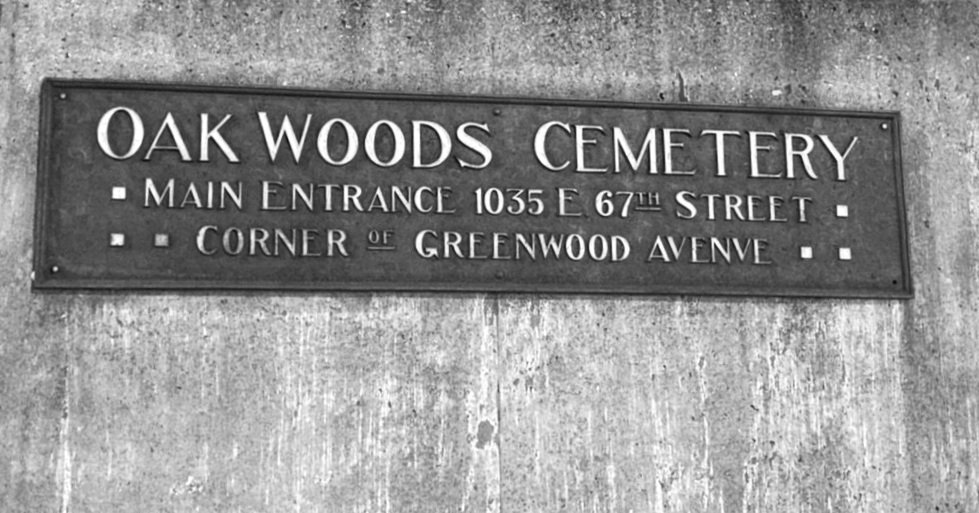
Early Black Burials at Oak Woods
While Oak Woods Cemetery is now the final resting place for thousands of influential black Chicagoans, the cemetery perpetuated discrimination and segregation for decades. These anti-black practices were seen first in charging blacks more money for burial plots, and then an all together refusal to sell burial plots to blacks following the great migration. Prior to the great migration, the cemetery appears to have been integrated as we have found evidence of many black individuals buried at Oak Woods.
In 1899, an early civil rights activist, Richard Mason Hancock was buried in Oak Woods. Richard Mason Hancock was a skilled iron worker and tradesman. Prior to coming to Chicago, he lived in New Haven, CT where he served as the Secretary of New Haven Negroes Against Colonization and worked in white owned law firms. He left his mark on Chicago, serving as a public official and serving as secretary of the board in the pioneering colored nurses training program at Provident Hospital.
Earlier, in 1890, Lieutenant Alexander D. Bailie would also call Oak Woods a final resting place. Bailie served in the Civil War in the 65th Regiment, United States Colored Infantry and was buried in a soldiers grave following his tragic suicide. In 1888, Zephyr Davis, a black teenager who allegedly killed his white co-worker, was also buried in the cemetery after being hanged in the Cook County jail. The location of the grave was kept confidential due to the public attention this drew. Author Elizabeth Dale analyzes this disturbing crusade influenced by public opinion against the young Davis in her book, “The Rule of Justice: The People versus Zephyr Davis.”

The Rise of Discrimination Following the Great Migration
According to former President of Oak Woods, Bruce Holstrom, from around the 1920s through the 1960s, Oak Woods did not accept African Americans at the cemetery unless they had previously owned plots or white families had purchased the plots on their behalf.
During WWI, black workers from the south began moving to northern cities to meet the demand caused by the labor shortage. However, while this was a time when many predominately black neighborhoods began to flourish- so did anti-black sentiments and practices. More cemeteries began implementing discriminatory practices and prohibiting the burial or cremation of blacks. Several South Side black cemeteries began to appear including Lincoln Cemetery in 1911 and Burr Oak Cemetery in 1927, in Alsip, IL. Mount Forest Cemetery in Thorton was also a black cemetery that operated from 1909 to 1939. In The Master's Slave, Elijah John Fisher: A Biography, it mentions that upon the death of a church member in 1908, their church was forced to pay considerably more for a burial plot than that of white individuals. In the book, it mentions Reverend Fisher remarking that having a cemetery for the black community is something that he wanted to see. He later became a supporter of development of Mount Forest Cemetery.
Between the 1920s-1930s, a few notable black residents were permitted burial. Nancy Green, commonly marketed as “the first aunt Jemima” was buried in an unmarked grave in Oak Woods following her death in 1923. Despite the popularity of the racist “mammy caricature,” she did not receive a tombstone until 2020 when the Bronzeville Historical Society raised funds to purchase one.
Another notable burial during this time period was that of great civil rights leader and journalist Ida B. Wells Barnett following her death in 1931. Wells was one of the founders of the National Association for the Advancement of Colored People (NAACP). These burials were the few “exceptions” made during this time period. It is likely that they had purchased plots prior to the cemetery’s attempts to restrict black burials all together, or that white families purchased the plots on their behalf.
Cremation was also a practice in which cemetery officials continued to discriminate against the black community. W. B. Currie was the superintendent of Oak Woods Cemetery, and also served as the President of the Cremation Association of America. According to The Cremation Association of America’s (CAA) meeting minutes in 1939 “CAA President Currie said the rules at his crematory allowed only Caucasian cremations; he did not take African Americans.”
In May 1963, a protest led by black community leaders protesting the cemetery after Oak Woods officials refused to cremate the body of a young woman, Alvesta Wilson. The NAACP worked with Rev. Clay Evans and Rev. A. R. Leak, and rallied hundreds of individuals to the gates of the cemetery to stand in peaceful protest.
Read more about Spencer Leak, Sr (son of Reverend A.R. Leak) and the Leak Family Legacy
Can You Help?
In our research, we learned that the Charles S Jackson Co. filed a lawsuit against Oak Woods in 1953. Do you know more about this? Contact us with resources or stories you want to share!

Following the 1963 protest, the cemetery that once segregated and excluded the black community, began advertising in newspapers like South Side Journal, which was a publication that predominately served majority black communities on the South Side.
The advertisement on the left appeared in the Chicago Tribune on October 24, 1990.
The advertisement on the right appeared in the South Side Journal on April 4, 1994. To read the entire paper click here.

Oak Woods Today
Today, Oak Woods Cemetery has continued to evolve from it’s storied history of discrimination against the black community. The cemetery is the final resting place for black Chicagoans that have changed the course of history. We encourage you to visit our biographies page and read more about the notable leaders below. If you want to visit the cemetery to see the graves in person, see our digital map.







